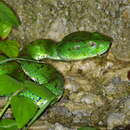en
names in breadcrumbs


Trimeresurus flavomaculatus (Philippine pit viper)[4] is a venomous pit viper species endemic to the Philippines. Two subspecies are currently recognized, including the nominate subspecies described here.[5]
According to Leviton (1964), the scalation includes 21 rows of dorsal scales at midbody, 170–178/175–184 ventral scales in males/females, 62–71/58–63 subcaudal scales in males/females, and 9–11 supralabial scales of which the 3rd is the largest. Toriba and Sawai (1990) give 167–179/172–184 ventral scales in males/females, 56–70/53–63 subcaudal scales in males/females, and 9–10/9–12 supralabial scales in males/females.[4]
Found on the Philippine islands of Agutayan, Batan, Camiguin, Catanduanes, Dinagat, Jolo, Leyte, Luzon, Mindanao, Mindoro, Negros, and Polillo. The type locality given is "Philippine Islands". Leviton (1964) proposed that this be restricted to "Luzon Island".[2]
Gumprecht (2001, 2002) relegates T. f. halieus to synonymy and elevates T. f. mcgregori to a full species.[4]
{{cite journal}}: CS1 maint: multiple names: authors list (link) Trimeresurus flavomaculatus (Philippine pit viper) is a venomous pit viper species endemic to the Philippines. Two subspecies are currently recognized, including the nominate subspecies described here.